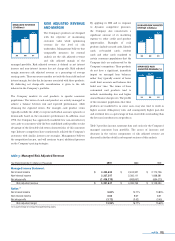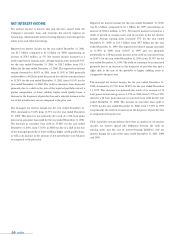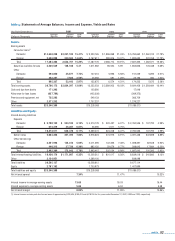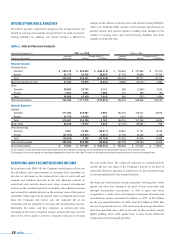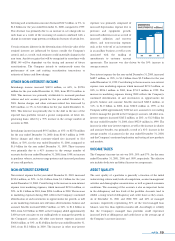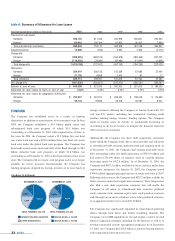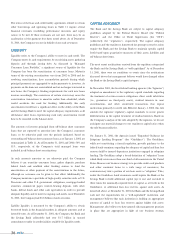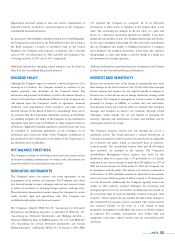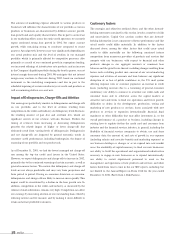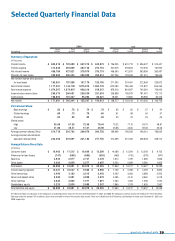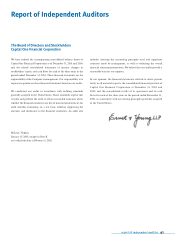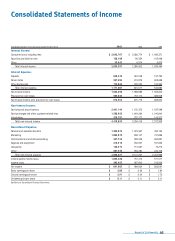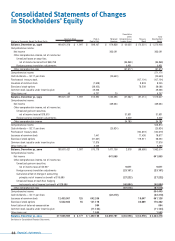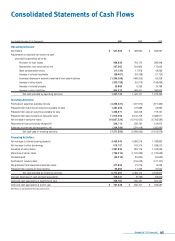Capital One 2001 Annual Report Download - page 37
Download and view the complete annual report
Please find page 37 of the 2001 Capital One annual report below. You can navigate through the pages in the report by either clicking on the pages listed below, or by using the keyword search tool below to find specific information within the annual report.
Significantly increased capital or loan loss reserve requirements, if
imposed, however, could have a material impact on the Company’s
consolidated financial statements.
In connection with the Bank’s subsidiary bank in the United Kingdom,
the Company has committed to the Federal Reserve that, for so long as
the Bank maintains a branch or subsidiary bank in the United
Kingdom, the Company will maintain a minimum Tier 1 leverage
ratio of 3.0%. As of December 31, 2001 and 2000, the Company’s Tier
1 leverage ratio was 11.93% and 11.14%, respectively.
Additional information regarding capital adequacy can be found in
Note K to the Consolidated Financial Statements.
DIVIDEND POLICY
Although the Company expects to reinvest a substantial portion of its
earnings in its business, the Company intends to continue to pay
regular quarterly cash dividends on the Common Stock. The
declaration and payment of dividends, as well as the amount thereof, is
subject to the discretion of the Board of Directors of the Company and
will depend upon the Company’s results of operations, financial
condition, cash requirements, future prospects and other factors
deemed relevant by the Board of Directors. Accordingly, there can be
no assurance that the Corporation will declare and pay any dividends.
As a holding company, the ability of the Company to pay dividends is
dependent upon the receipt of dividends or other payments from its
subsidiaries. Applicable banking regulations and provisions that may
be contained in borrowing agreements of the Company or its
subsidiaries may restrict the ability of the Company’s subsidiaries to
pay dividends to the Corporation or the ability of the Corporation to
pay dividends to its stockholders.
OFF-BALANCE SHEET RISK
The Company is subject to off-balance sheet risk in the normal course
of business including commitments to extend credit and interest rate
sensitivity related to its securitization transactions.
DERIVATIVE INSTRUMENTS
The Company enters into interest rate swap agreements in the
management of its interest rate exposure. The Company also enters
into forward foreign currency exchange contracts and currency swaps
to reduce its sensitivity to changing foreign currency exchange rates.
These derivative financial instruments expose the Company to certain
credit, market, legal and operational risks. The Company has
established credit policies for these instruments.
The Company adopted SFAS No.133, “Accounting for Derivative
Instruments and Hedging Activities,” as amended by SFAS No. 137,
“Accounting for Derivative Instruments and Hedging Activities –
Deferral of Effective Date of FASB Statement No. 133,” and SFAS No.
138, “Accounting for Certain Derivative Instruments and Certain
Hedging Activities,” (collectively,“SFAS 133”) on January 1, 2001. SFAS
133 required the Company to recognize all of its derivative
instruments as either assets or liabilities in the balance sheet at fair
value. The accounting for changes in the fair value (i.e., gains and
losses) of a derivative instrument depends on whether it has been
designated and qualifies as part of a hedging relationship and further,
on the type of hedging relationship. For those derivative instruments
that are designated and qualify as hedging instruments, a company
must designate the hedging instrument, based upon the exposure
being hedged, as a fair value hedge, a cash flow hedge or a hedge of a
net investment in a foreign operation.
Additional information regarding derivative instruments can be found
in Note O to the Consolidated Financial Statements.
INTEREST RATE SENSITIVITY
Interest rate sensitivity refers to the change in earnings that may result
from changes in the level of interest rates. To the extent that managed
interest income and expense do not respond equally to changes in
interest rates, or that all rates do not change uniformly, earnings could
be affected. The Company’s managed net interest income is affected
primarily by changes in LIBOR, as variable rate card receivables,
securitization bonds and corporate debts are repriced. The Company
manages and mitigates its interest rate sensitivity through several
techniques, which include, but are not limited to, changing the
maturity, repricing and distribution of assets and liabilities and by
entering into interest rate swaps.
The Company measures interest rate risk through the use of a
simulation model. The model generates a normal distribution of
12-month managed net interest income outcomes based on a plausible
set of interest rate paths, which are generated from an industry-
accepted model. The consolidated balance sheet and all off-balance
sheet positions are included in the analysis. The Company’s
Asset/Liability Management Policy requires, that based on this
distribution, there be no more than a 5% probability of a 12-month
reduction in net interest income of more than $50 million, or 1.4% of
2001 net interest income. As of December 31, 2001, the Company was
in compliance with the policy. The interest rate scenarios evaluated as
of December 31, 2001, included scenarios in which short-term interest
rates rose by over 400 basis points or fell by as much as 170 basis points
over the 12 months. Additionally, the Company regularly reviews the
output of other industry accepted techniques for measuring and
managing exposures to rate movements, including measures based on
the net present value of assets less liabilities (termed “economic value
of equity”). These analyses do not consider the effects from changes in
the overall level of economic activity associated with various interest
rate scenarios. Further, in the event of a rate change of large
magnitude, management would likely take actions to further mitigate
its exposure. For example, management may, within legal and
competitive constraints, reprice interest rates on outstanding credit
card loans.
md&a 35


